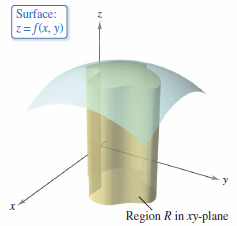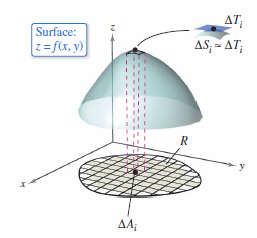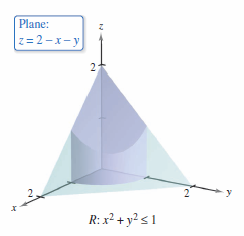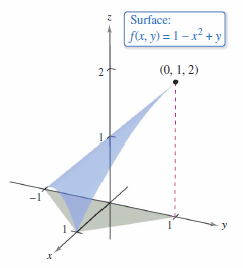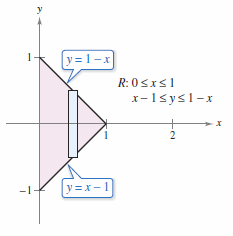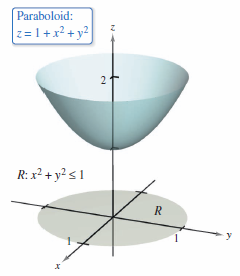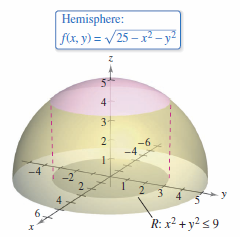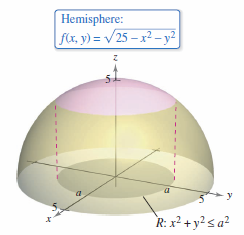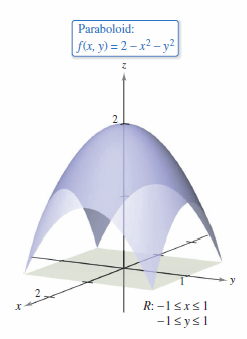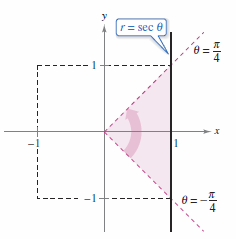Calculus III 14.05 Surface Area
| Previous | Calculus III 14.04 Mass Center and Inertia Moments |
| Next | Calculus III 14.06 Triple Integrals and Applications |
14.05 Surface Area
- Using double integrals to find surface area.
Surface Area
|
|
Consider the upper surface area for a solid, as shown in Figure 14.5.1. The surface area \(S\) given by
defined over a region \(R\). Assume that \(R\) is closed, bounded, and that \(f\) has continuous first partition derivatives. Find the surface area by constructing an inner partition for \(R\) with \(n\) rectangles, where the area for the \(i\)th rectangle \(R_{i}\) is
as shown in Figure 14.5.2. In each \(R_{i}\), let \((x_{i},y_{i})\) be the point that is closest to the origin. At the point
on the surface \(S\), construct a tangent plane \(T_{i}\). The \(T_{i}\) portion that lies above \(R_{i}\) is approximately equal to the surface area lying directly above \(R_{i}\). Expressed as an equation,
Therefore, the surface area for \(S\) is approximated by
To find the area for the parallelogram \( \Delta T_{i} \), note that its sides are bounded by the vectors
and
From Theorem 11.4.2, the area for \( \Delta T_{i} \) is given by \(\| \textbf{u} \times \textbf{v} \| \), where
The surface area for \( \Delta T_{i} \) is
and
This relationship is described in Definition 14.5.1. |
Definition 14.5.1 Surface Area
If \(f\) and its first partial derivatives are continuous on the closed region \(R\) in the \(xy\)-plane, then the surface area \(S\) given by \(z=f(x,y)\) over \(R\) is defined as
| Surface area | $$= \int_{R} \int \: dS$$ |
| $$ = \int_{R} \int \sqrt{ 1 + [f_{x}(x_{i},y_{i})]^{2} + [f_{y}(x_{i},y_{i})]^{2} } \: d A. $$ |
Example 14.5.1 The Surface Area for a Plane Region
|
|
Find the surface area for the plane
that lies above the circle
in the first quadrant, as shown in Figure 14.5.3.
and
the surface area is given by
Note that the last integral is \(\sqrt{3} \) times the area for the region \(R\). Since \(R\) is a quarter circle with radius 1, with an area \( 1/4 \pi (1^{2})\) or \(\pi /4\). The area for \(S\) is
|
Example 14.5.2 Finding Surface Area
|
|
Find the area for the surface
that lies above the triangular region with vertices \((1,0,0),\: (0,-1,0)\), and \((0,1,0)\), as shown in Figure 14.5.4.
The bounds for \(R\) are \(0 \leqslant x \leqslant 1\) and \(x-1 \leqslant y \leqslant 1-x\), as shown in Figure 14.5.5. The integral becomes
|
Example 14.5.3 Variables Changed to Polar Coordinates
|
|
Find the surface area for the paraboloid
that lies above the unit circle, as shown in Figure 14.5.6.
Let \(x= r \cos \theta\) and \(y=r \sin \theta\) to convert from cartesian to polar coordinates. The region \(R\) is bounded by \(0 \leqslant r \leqslant 1 \) and \(0 \leqslant \theta \leqslant 2 \pi\), producing
|
Example 14.5.4 Finding Surface Area
|
|
Find the surface area \(S\) for the hemisphere
that lies above the region \(R\) bounded by the circle \(x^{2}+y^{2} \leqslant 9\), as shown in Figure 14.5.7.
and
Adding the formula for surface area produces
The surface area is
Convert to polar coordinates by letting \(x= r \cos \theta\) and \(y=r \sin \theta\). The region \(R\) is bounded by \(0 \leqslant r \leqslant 3\) and \(0 \leqslant \theta \leqslant 2 \pi\), this produces
|
|
|
Example 14.5.4 can be extended to find the surface area for a sphere by using the region \(R\) bounded by the circle \(x^{2}+y^{2} \leqslant a^{2}\), where \( 0 < a < 5 \), as shown in Figure 14.5.8. The surface area for the hemisphere above the \(xy\)-plane is
This produces
Taking the limit as \(a\) approaches 5 and doubling the result yields the total area at \(100\pi\). The surface area for a sphere with radius \(r\) is \(S=4\pi r^{2}\). |
Example 14.5.5 Approximating Surface Area by Simpson’s Rule[1]
|
|
Find the surface area for the paraboloid
that lies above the square region bounded by \(-1 \leqslant x \leqslant 1 \) and \(-1 \leqslant y \leqslant 1\), as shown in Figure 14.5.9.
and
produces
In polar coordinates, the line \(x=1\) is given by
or
One quarter of region \(R\) is bounded by
and
as shown in Figure 14.5.10.
Applying Simpson's Rule with \(n=10\) approximates the surface area to
|
Internal Links
Parent Article: Calculus III 14 Multiple Integration
